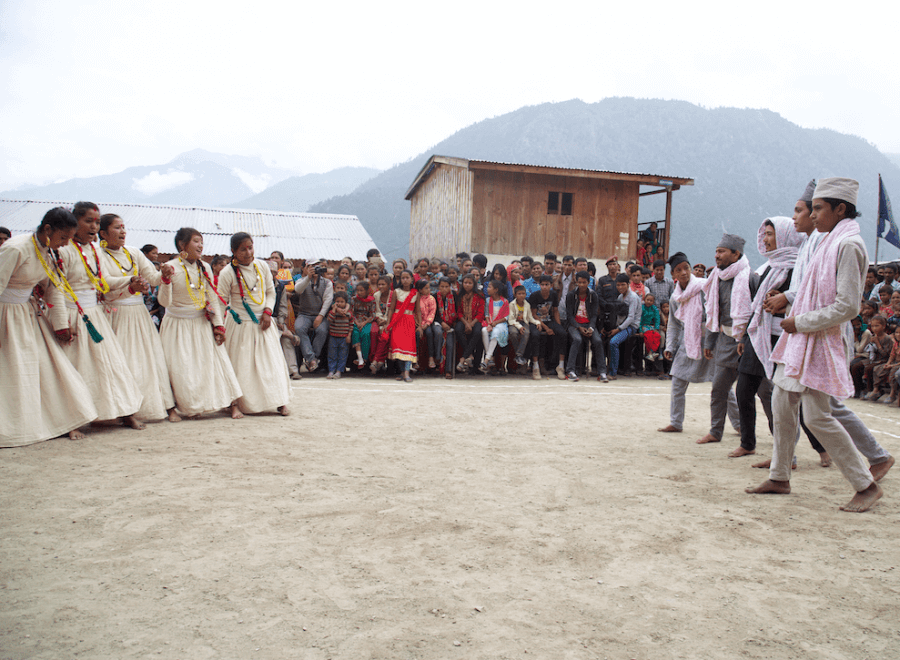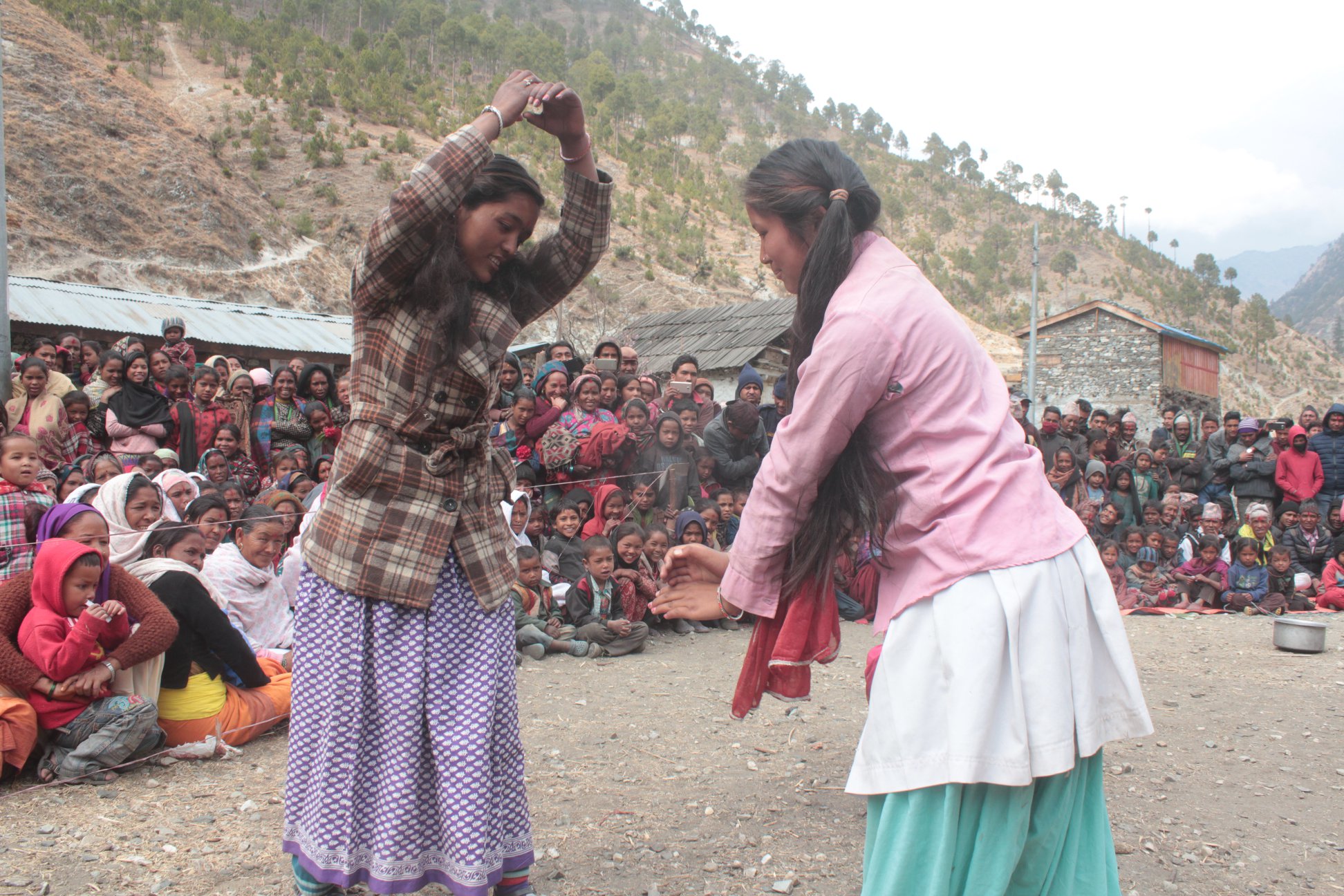
Karnali Arts Centre, over the years, has performed more than 3,000 street plays travelling across the remotest villages of Karnali. Photo Courtesy: Karnali Arts Centre
Throughout September in 2008, at the Rimal Hall of the now-defunct Gurukul Theatre, an acclaimed Nepali play was staged. This play, many theatre professionals believe, was responsible for changing the course of Nepali theatre.
Created under the leadership of Min Bahadur Bham, a popular name in Nepali theatre and films, the play, 'Karnali Dakkhin Bagdo Cha' (Karnali Flows Southward) highlighted the hardships of people who lived in the remote Karnali region.
From casting local actors to using the local Khas bhasa (Khas language), the makers of the play left no stone unturned in ensuring the play's authenticity, which perhaps became its biggest selling point, believes Hira Bijuli Nepali, who was one of the actors in the play.
"The play’s shows ran housefull. In Kathmandu, people from all walks of life– including academia and politics–came to watch our performances and many from outside the Valley also came with their families to watch the show," says Hira.
According to Hira, the play was a turning point in the history of modern Nepali theatre. After the play was staged, Hira claims that many Nepali theatre houses followed their lead and started focusing on realistic portrayals of human issues as their main subject in their productions. But the most prominent outcome of the play, he thinks, was the self-realisation among the local actors like him about the importance of telling personal stories and being in control of one’s narrative.
"For most of us who were from Karnali and were involved in theatre, it was an eye-opening experience. Before, we had never thought even in our imagination we could use theatre as a medium to talk about our experiences, grief, and culture," says Hira, who was born and brought up in Karnali’s Mugu. “We never had this collective urge to work on telling stories of our soil—in our own language.”
After the success of ‘Karnali Dakkhin Bagdo Cha’, according to Hira, they were encouraged to produce and act in plays that were authentic and represented the stories of Karnali and its people.
Hira says this newly developed consciousness among Karnali artists inspired him to create a space that preserved the region’s arts and culture. Thus, under his leadership, in 2012, Karnali Arts Centre was established in Gamgadhi, Mugu.
And for the last one decade, it has been serving as a repository of Karnali's local art, music, dance and culture.
Using the local actors who speak the local language, the art centre dedicates its time and energy by performing street plays, through which they address pertinent social issues like caste-based prejudices, gender discrimination and climate change, among others. Karnali Arts Centre, over the years, has performed more than 3,000 street plays travelling across the remotest villages of Karnali, where the actors even walked for more than two days for their performance.
But unlike other street plays that are performed throughout the country, the art centre's approach to their performances is different.
According to Hira, whenever they are performing, they don't only act original plays in front of their audience; the local music instruments and dance forms are also used to support the narrative.
"From performing ethnic dances like Deuda, Hudke, Jhuma and Champa to using local instruments like damaha and others in the street plays, we always perform using multidisciplinary approaches," says Hira. “For us, it is important to use varied forms of local arts and culture, as we believe that it's the best way through which we can amplify the message we want to deliver.”
For Prabhakar Gautam, a journalist and arts writer at news website Setopati, the works of Karnali Arts Centre stand out from other plays because of its multidisciplinary approach.
"Unlike the usual plays that we see, their plays are musical. The art centre’s members like Hira have a deeper understanding of how music and other forms like dance can be used to make the narrative strong," says Gautam, who's also a member of Raithane, a collective that works on preserving the ethnic-folk music and culture of Nepal. “As they don't follow the usual form of storytelling where only acting is used to convey the play’s message, their works are distinct and deeply rooted in the traditions of Karnali.”
Hira says that besides street plays, the centre time and again also organises various workshops on other avenues of art, including photography, painting, storytelling and acting among others. Similarly, it has also performed plays like ‘Pampha Phool’ and ‘Garbha Chhita’ on the premises of many well-known theatre houses in Kathmandu. Over the years, the art centre has hosted many art and photo exhibitions, helping the local artists get a platform to showcase their artistic talents.

Karnali Arts Centre was established in Gamgadhi, Mugu, under the leadership of Hira Bijuli Nepali. Photo courtesy: Karnali Arts CentreHowever, at the core, whatever artform they use, the goal of their centre has always remained constant: to preserve and question our culture through their works.
"At Karnali Arts Centre, we don’t only tell our stories in our language using the local cultural heritage, but we also voice out the ills of our society," says Hira. “Both the urgency of preserving our ancient traditions that have been looked down on in our society because of the elitist understanding of art and the need to question our faith and our cultural practices drive the members of the art centre to do their work sincerely.”
But initially, before it became an art centre that promotes holistic approaches to art, Hira, who has acted in several plays, says the original plan was to start a theatre. In 2008, just after 'Karnali Dakkhin Bagdo Chha' was performed in Kathmandu, Hira, Bham and many local artists were driven to open a theatre in Karnali. They thought that the best way to achieve their mission of preserving Karnali's culture and local stories was by opening a theatre.
"We wanted to create a space dedicated for performing plays," says Hira, joining the dots from his past memories.
But opening a theatre in a remote area like Karnali–where people can't even avail of essential services like transportation and healthcare–was bound to be complicated. There were many roadblocks like the lack of financial resources they had to face. And because of such constant challenges, a conscious decision was made by the team to keep the plan of building a theatre aside and shift the focus on creating a community art centre instead, shared Hira.
"We didn’t have the financial resources to build a theatre. Hence, we decided to change our direction and diverted our energy into starting an art centre that encompassed all forms of art. We believed by doing so we could reach a larger number of audience living in remote villages of Karnali who otherwise don’t have access to art," says Hira.
The concept of a community art centre was something that instantly appealed to the team members as they thought that creating an art centre would allow people from all walks of life to have easy access to arts and its limitless possibilities. Similarly, instead of making people come to them to watch a play or participate in any events, they believed that bringing art to the public by performing in the streets would be more effective.
"In playgrounds, in schools, in any open space we could find, we performed plays, dances and musicals for the locals as we wanted more people to be informed about arts," says Hira.
However, even if opening up an art centre didn't require a lot of infrastructure and resources like a theatre needs, to start one of Karnali's first art centres wasn't easy for Hira and his team. As the culture of watching plays and appreciating artworks was nonexistent in Karnali, Hira says, during its inception, the team members of Karnali Arts Centre had to face a lot of rejections from the locals.
"They didn't understand why art and theatre were important. They had this idea that those who did plays were 'lunatics'. Thus it was challenging for us to develop an art appreciation culture among the locals and also convince them that art like plays has an immense value," he says.
Hira remembers how the team members would go to villages to perform.
"Sometimes we walked for two consecutive days as we wanted to reach every corner we could in Karnali to perform plays and make people understand the power of arts," says Hira.
Although it took almost a decade, things have changed.
Now the locals who in the beginning didn't take their works seriously are now gradually opening up and are making efforts to understand the works of the art centre. Hira says that they even actively participate now, understand the value of the tangible and intangible heritages and show interest in being part of plays.
But the most significant impact Karnali Arts Centre has made over the years is engaging people in conversations related to caste and gender through their works, say the local actors.
As most of the centre's members belong to the Dalit community, the art centre, Hira says has always made a conscious effort to shed light on the cultural practices that promote and normalise prejudices against the marginalised communities.
And because of the constant engagement with issues related to social justice, many people– especially those who are forced to remain on the fringe–are speaking against discrimination more than ever.
"Before I got exposed and became part of their plays, I didn't speak much against the discriminatory behaviour that I had to face. I would always remain silent," says Samjhana Nepali, a local actor. "But now, I have understood that people from marginalised groups like me should speak against the ills that have been practised for years in the name of the culture. And the credit goes to the art centre.”
Samjhana played the lead role of Pampha in the play, 'Pampha Phool', which was produced by the art centre.
She says she has learned to speak up and educate others on the need to work collectively to dismantle the ill practices.
For locals, who spoke to the Post, Karnali Arts Centre has become more than a cultural hub that stages street plays. In their works, they have found themselves, their culture, and their voices.
"Karnali Art Centre doesn't function only as an art centre or a cultural space. It has become a forum through which the voices of Dalit and marginalised communities get amplified while it serves as a repository of our culture,” says Jarman Nepali, a sociologist and local activist in Mugu. "It won't be wrong to say that they have set an example of how powerful art can be and how to use it for a cause."
Hira says while he's content with the impact the art centre has made over the years, there's still much more to do.
"Financially, it's always been difficult for us. Although the kind of work we are engaged in doesn't guarantee a financial return, we want to create an environment for our actors to sustain themselves," says Nepali. "But for us, money is always secondary. We are more focused on doing works that preserve as well as question our culture."













